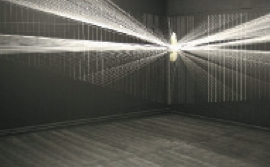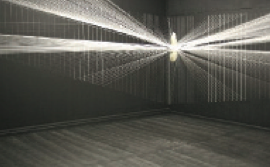Milton Becerra
Durban Segnini, Miami
In its Miami venue, Durban Segnini Gallery presented “ALE’YA” (book of the principle of written truths), the solo show of Venezuelan artist Milton Becerra (Colón, 1951), who has been living and working in Paris since 1980. In this exhibition the artist resorted to his customary organic materials (rocks, animal hides, vegetal ropes, virgin wax) on synthetic supports, and he adopts as referents the myths and symbols of the Wayúu ethnicity. Consisting mainly of wallworks (medium and large-scale pieces), and including a metal sculpture and an installation, the show proposed a balance between contemporary civilization and the most primitive and ancestral elements in human culture and natural history, in their geologic and biologic genesis.

The curator, Adolfo Wilson, pointed out that “the organic and the geometric, the intuitive and the rational coexist, harmonize and fuse without conflict in these works, (...) whose harmo- nious spatial organization appears to be based on the principles of symmetry, correspondence and proportion, since a metric, mathematical and geometric order animates these composi- tions.” Indeed, Becerra’s work aligns in a very peculiar way with the modernist trend of virtual Op and Kinetic art, repre- sented in Venezuela by such important masters as Jesús Rafael Soto and Carlos Cruz-Diez, but he achieves a successful and harmonious counterpoint between that avant-garde visual dis- course and the heritage of the tradition and imaginary of pre- Columbian American cultures. On the other hand, his works are structured on the basis of the principle of eurhythmy (harmo- nious and aesthetic bodily movement, redefined by the Austrian philosopher Rudolf Steiner as the art of anthroposo- phy, which enables us to relate to our environment through movement), but in this case he addresses the virtua movement of the eye guided by beauty: the Cartesian weft made up of color and geometric forms is balanced by the natural eurhyth- my of organic forms, that Golden Mean that is inexorably met by the proportions and shapes of all natural objects: the arrangement of the veins in a leaf, the spirals in a snail’s shell, the cracks in dry soil, the proportions of the human body.
Milton Becerra’s art is also the bearer of numerous sexual sym- bols and archetypes, that universal and eternal theme that has been central in the life of all cultures and of all individuals, gen- erally represented through the natural shapes of the unpolished rocks he incorporates in his works. They fuse biologic and geo- logic origins as an absolute metaphor for the primeval, the mas- culine principle and the feminine principle embodied by the elongated or oval shapes of the rocks and the space created by the rope net that contains them. The large installation that occu- pied a whole corner of the exhibition space was the best exam- ple of this narrative of fruitfulness: a rock floats vertically erect amidst light beams that support it as if it were at the center of the universe, evoking an era preceding the existence of every- thing, or more precisely, at the very origin of everything




